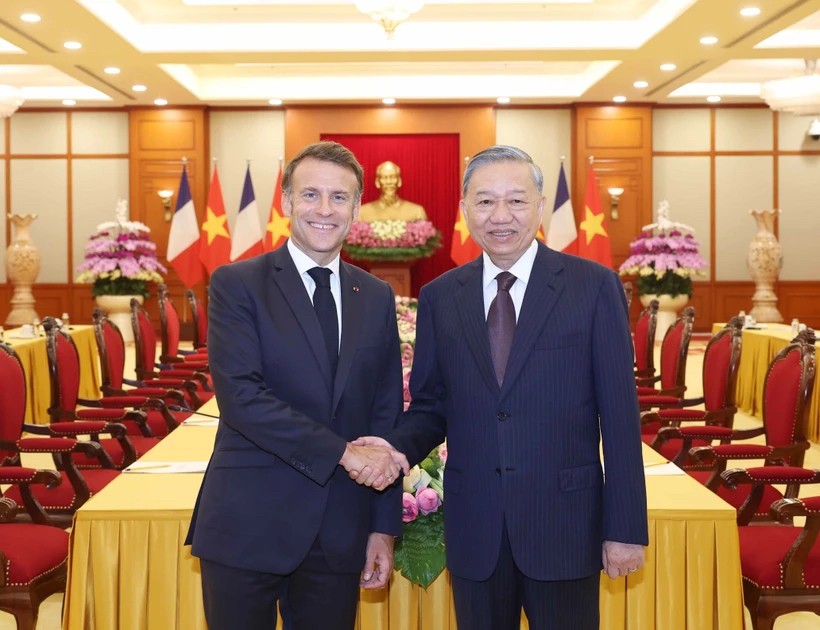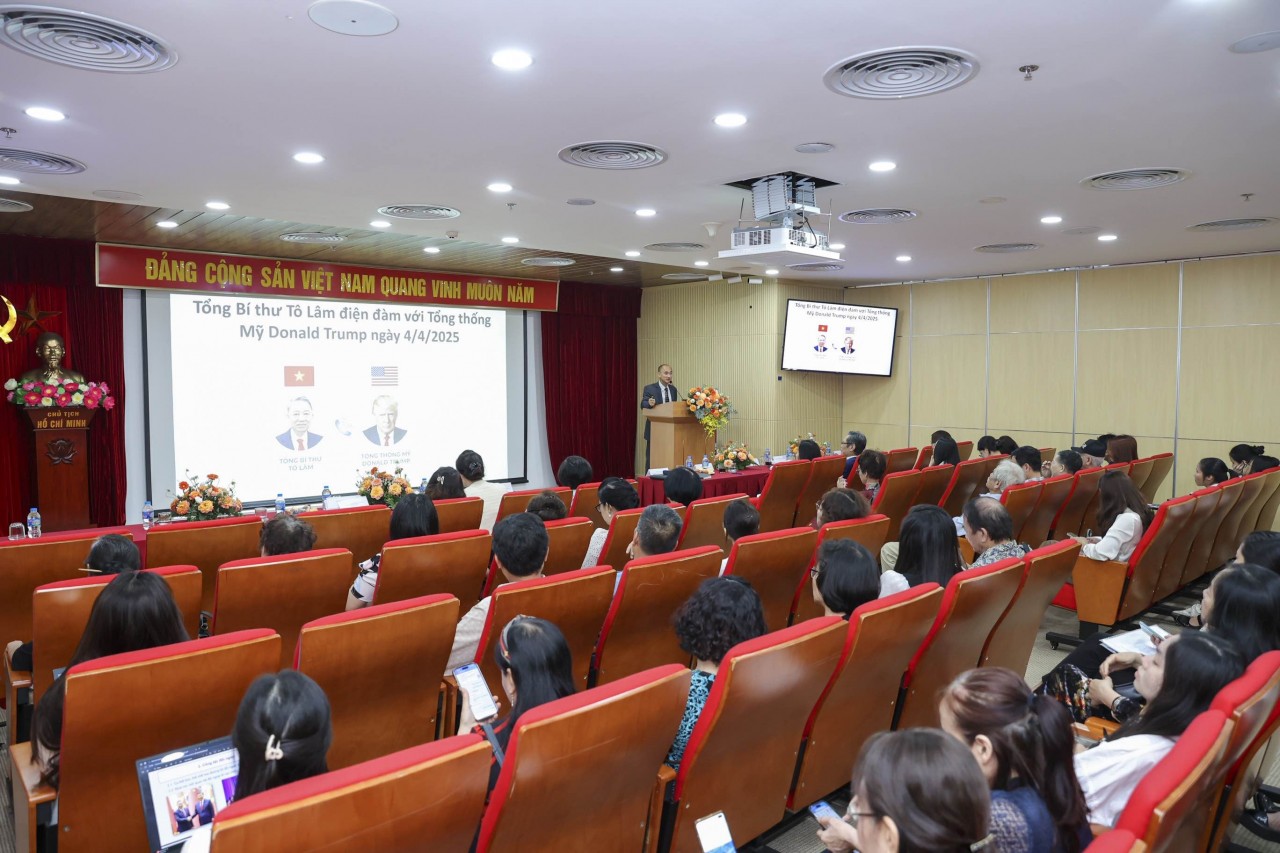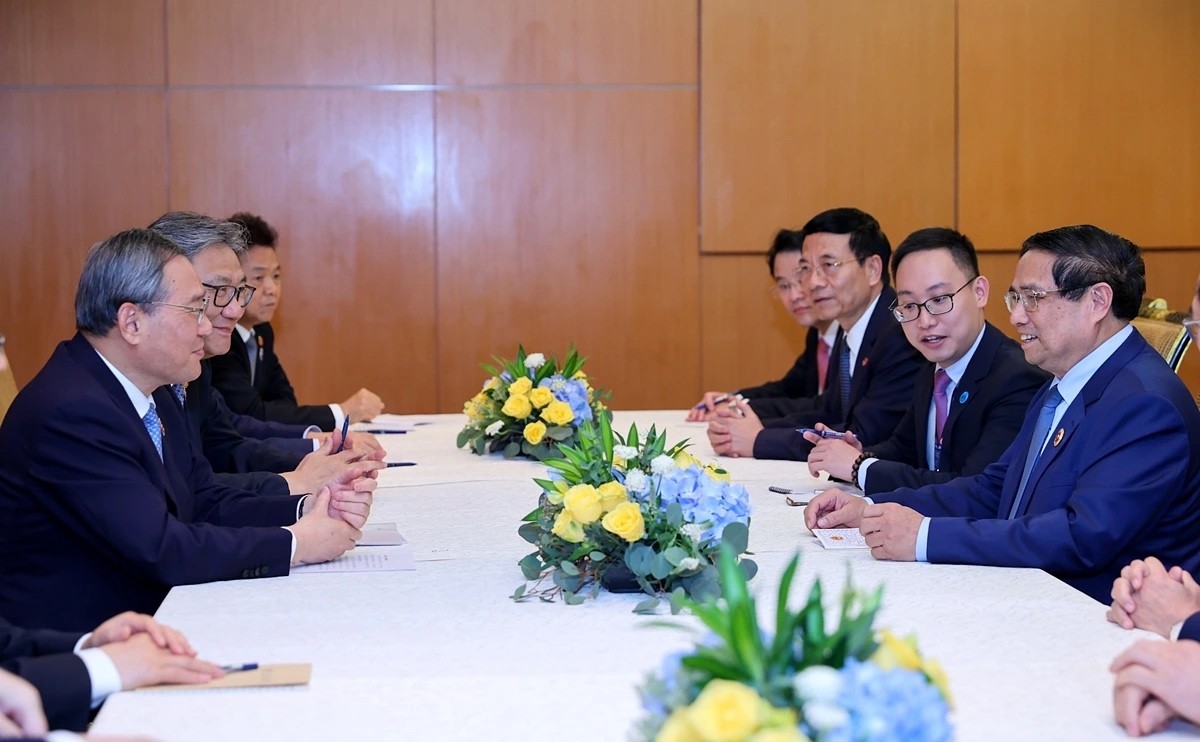Vietnam News Today (Nov. 12): Vietnam, Chile Look to Advance Bilateral Ties
| Vietnam News Today (Nov. 9): Vietnam And Laos Vow to Effectively Implement High-level Agreements | |
| Vietnam News Today (Nov. 10): Vice President’s Official Visit Helps to Foster Closer Ties With Sweden |
| Vietnam News Today (Nov. 12) notable headlines Vietnam, Chile look to advance bilateral ties Ample room for Vietnam and Peru to boost trade ties Vietnam a unique destination attracting Indian tourists: Indian newspaper Yinxing weakens into tropical depression, Toraji enters East Sea Vietnam positions itself as a key player in the global semiconductor boom Vietnam attends cultural exchange festival in Hong Kong (China) Vietnamese President warmly welcomed in Santiago de Chile on official visit Hanoi exhibitions features President Ho Chi Minh’s footprints in China Vietnamese youth in France celebrate 20 years of unity, achievements |
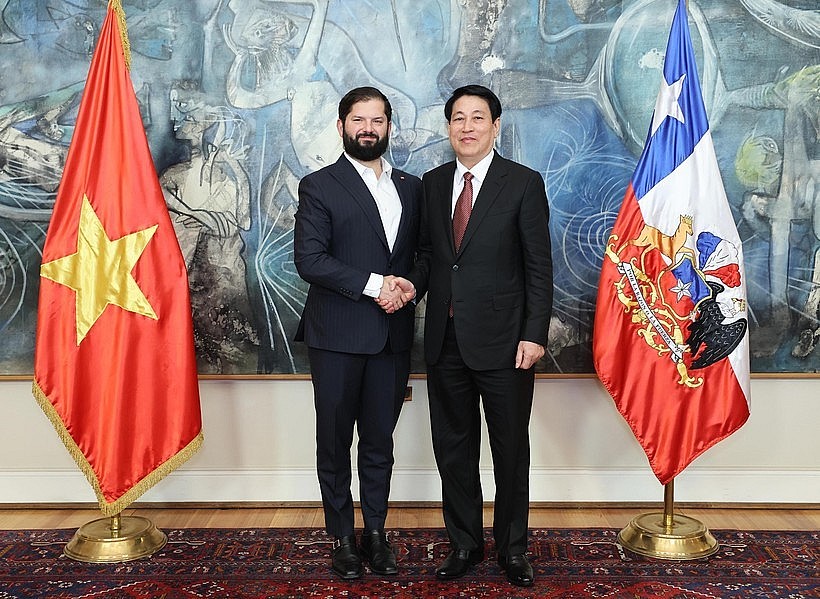 |
| Vietnamese State President Luong Cuong (R) and President of Chile Gabriel Boric Font (Photo: VNA) |
Vietnam, Chile look to advance bilateral ties
Vietnamese State President Luong Cuong and President of Chile Gabriel Boric Font discussed measures to enhance the relationship between the two countries, making it more intensive, substantive, and pragmatic, towards advancing it to a higher level, during their talks in Santiago de Chile on November 11 morning (local time).
The leaders informed each other of the situation in their respective countries and exchanged views on the bilateral ties.
Stressing the significance of Cuong’s ongoing official visit, the first by a Vietnamese State President over the past 15 years, Gabriel Boric expressed his hope that the trip will help deepen the traditional friendship and multifaceted cooperation between the two countries.
The host noted his admiration for Vietnam’s achievements in national construction and development, especially those recorded in the Doi Moi (Renewal) cause, considering them valuable experiences for Chile to learn from.
Chile always treasures and wishes to enhance the relations with Vietnam in its policy towards the Asia-Pacific, especially in the context that the two countries are celebrating the 10th anniversary of the implementation of their bilateral free trade agreement, and both are members of the Comprehensive and Progressive Agreement for Trans-Pacific Partnership (CPTPP), he said.
Cuong, for his part, affirmed the importance Vietnam places on its traditional friendship and comprehensive partnership with Chile, the first South American country to establish diplomatic relations with Vietnam on March 25, 1971.
The leader expressed his gratitude to the Chilean people for their invaluable support for Vietnam during its past struggle for national independence and reunification, as well as the present cause of national defense and construction.
Cuong said his visit aims to affirm that Vietnam wants to strengthen the bilateral comprehensive partnership, saying it holds special significance, coinciding with the 55th anniversary of the historic meeting between President Ho Chi Minh and President Salvador Allende in Hanoi on May 23, 1969, cited VNA.
The 1969 meeting laid the foundation for the establishment of the bilateral diplomatic relations in 1971 and the development of the Vietnam-Chile relations today, he said.
At the talks, the two leaders expressed their delight at the countries’ flourishing relations as seen in the maintenance of high-level mutual visits and meetings between their Parties, States, parliaments, and localities, as well as the fruitful implementation of existing cooperation mechanisms such as the free trade council and the political consultation at the deputy foreign minister level.
They held that economic and trade ties have continued to be consolidated amid many global economic challenges. Chile is the fourth largest trading partner of Vietnam in Latin America while the latter ranks first among trading partners of the former in the Association of Southeast Asian Nations (ASEAN).
The President highly valued Vietnam’s official establishment of a defense attaché office in Chile, expected to help further promote bilateral defense cooperation in the time ahead.
Besides, they also applauded the two countries’ close and effective cooperation at international organizations and inter-regional forums, especially the United Nations, the Asia-Pacific Economic Cooperation (APEC), the Forum for East Asia - Latin America Cooperation (FEALAC), and the ASEAN - Pacific Alliance cooperation.
They were unanimous on the need to foster collaboration in the fields matching the two sides’ strengths and concerns such as free trade, agriculture, sustainable development, renewable energy, science, education, tourism, defense, and security. Vietnam and Chile should actively negotiate and sign bilateral cooperation documents to perfect the legal framework for their relations to grow sustainably, while creating favorable conditions for their businesses to boost partnerships to raise bilateral trade on par with the countries’ potential.
The leaders agreed that their countries will enhance coordination, cooperation, and mutual support at international organizations along with multilateral and inter-regional forums.
Sharing the countries’ development visions along with support for free trade values and cooperation for common development and mutual benefits, they agreed to assign Vietnamese and Chilean ministries and sectors to discuss, review, and consider the elevation of the relationship in the coming time in order to create a broader space for bilateral cooperation, and identify breakthrough and strategic cooperation priorities.
The Presidents also looked into and shared their stances on many regional and international issues of common concern.
With regard to the East Sea issue, they perceived that sovereignty and territorial disputes should be resolved by peaceful means in accordance with international law, especially the UN Charter and the 1982 UN Convention on the Law of the Sea (UNCLOS).
On this occasion, Cuong conveyed regards from Party General Secretary To Lam, Prime Minister Pham Minh Chinh, and National Assembly Chairman Tran Thanh Man to his host. He also invited the Chilean President to visit Vietnam in the near future. Boric Font accepted the invitation with pleasure.
Following the talks, the two leaders witnessed the signing of a Vietnam - Chile joint statement by the two foreign ministers, a memorandum of understanding on defense cooperation between the two defense ministries, and some cooperation documents in the fields of agriculture, culture, and trade promotion. They also engaged in a joint press meeting.
Ample room for Vietnam and Peru to boost trade ties
Despite several challenges, including global economic volatility, market competition and geographical distance, both Vietnam and Peru have plenty of opportunity to increase their trade by leveraging incentives from free trade agreements and cooperation mechanisms.
Statistics unveiled by the General Department of Vietnam Customs show two-way trade between Vietnam and Peru reached US$486 million in 2023, including US$439 million worth of Vietnamese exports. The first nine months this year saw bilateral trade hit US$389.69 million, with Vietnamese exports at US$336.99 million. Peru is now Vietnam’s sixth largest trade partner in Latin America.
Vietnam’s main exports to Peru include phones and electronic components, computers and electronic products, footwear, clinker and cement, raw plastics, textiles, and seafood, while Peru’s main exports are fish meal, antimony ore, and minerals, according to VOV.
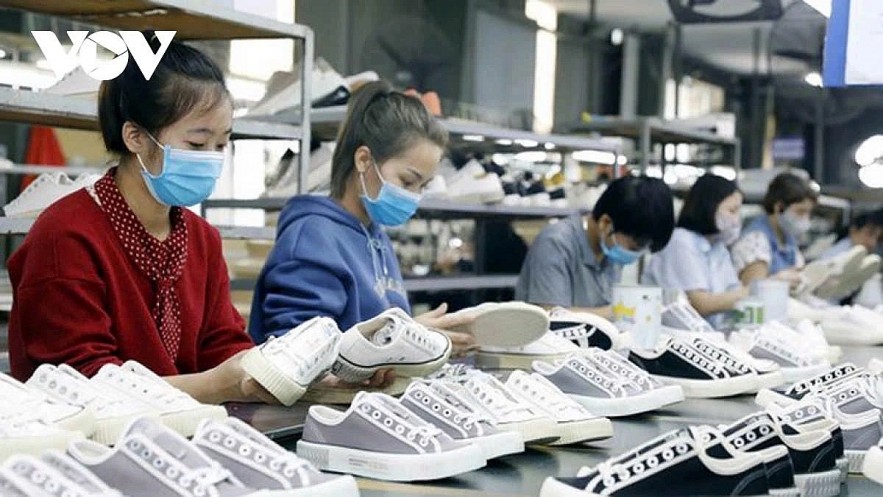 |
| Footwear is one of Vietnam's major export items to Peru. |
Despite challenges posed by global economic volatility, Vietnam and Peru still have significant room to increase trade in the coming years, as both are members of the Comprehensive and Progressive Agreement for Trans-Pacific Partnership (CPTPP). The Vietnam-Peru Intergovernmental Committee that meets every two years is an effective cooperation mechanism to promote bilateral and multilateral economic relations, leverage the CPTPP, and boost investment projects in both countries.
According to the European-American Markets Department, Peru is considered a dynamic economy with relatively open foreign trade policies in Latin America. It is a member of most international and regional institutions, including the World Trade Organization, Asia-Pacific Economic Cooperation, the Pacific Alliance, and Southern Common Market Mercosur. It has signed 22 free trade agreements (FTAs) with 58 countries, making it one of the most FTA-engaged countries in the region.
Moreover, Peru’s market is suitable for Vietnamese businesses in terms of market scale and approach. Most of its export-import companies are small and medium-sized enterprises, making Vietnamese products highly competitive and relatively easy to penetrate the market. Peru could also serve as a gateway for Vietnamese goods to enter neighboring markets like Ecuador, Colombia, Bolivia, and Brazil.
In addition, Peru is developing the Chancay mega-port located north of Lima on the Pacific coast, a highly strategic position for international trade connectivity. The port is expected to reduce transport time to Latin America by 30%, even up to 50%, and save logistics costs by up to 20% compared to traditional routes.
Leveraging advantages
However, geographical distance and language barriers are significant challenges to trade between the two countries. Although bilateral trade is increasing, it remains relatively low and is mostly conducted through intermediaries. Peru is also an open market with numerous FTAs with Vietnamese competitors such as China and Thailand, making it a relatively competitive market.
The Vietnamese Trade Office in Brazil and Peru suggests that to increase exports to Peru, businesses strengthen product promotion at fairs and exhibitions and promote Vietnamese products and culture through Peruvian media channels. Additionally, both sides should focus on developing logistics to enhance Vietnam’s logistics capacity, thus facilitating exports.
At a recent meeting with Eric Anderson, Secretary-General of the Peruvian Ministry of Foreign Affairs, Vietnamese Deputy Minister of Industry and Trade Nguyen Hoang Long affirmed Vietnam’s appreciation for Peru and its status as a key partner in Latin America. He emphasized the importance of the CPTPP coming into effect in Peru at the end of 2021, marking the first FTA between the two countries and creating new momentum for bilateral trade and investment cooperation.
To further strengthen trade cooperation, Long proposed that Peru actively promote exchange activities, explore potential negotiations, and sign cooperation agreements in mutually beneficial areas. He also suggested increasing information dissemination to help businesses in both countries capitalize on CPTPP opportunities and enhance trade promotion to encourage business engagement.
The Deputy Minister also proposed exploring potential cooperation in Peru’s mining, organic agriculture, food processing, and tourism industries, as well as developing green technology, digital economy, and e-commerce industries. Both countries should strengthen coordination and mutual support in international organizations and multilateral forums such as the United Nations, Organization for Economic Cooperation and Development, and Forum for East Asia-Latin America Cooperation, alongside APEC and CPTPP.
To boost exports to Peru, the Ministry of Industry and Trade (MoIT) advises Vietnamese businesses to thoroughly research consumer needs and preferences to align products with market demands. They should also participate proactively in trade promotion events and exhibitions in Peru and to leverage online media channels to promote brands to local consumers.
The MoIT encourages businesses to utilize CPTPP benefits, understand agreement commitments, especially tax incentives and product origin standards, and adhere to quality standards and labeling requirements to avoid delays or rejections at import ports.
Moreover, businesses need to develop a long-term, adaptable export strategy to navigate market fluctuations, including commodity prices and Peru’s political situation. The MoIT will continue to support businesses by connecting with Peruvian government agencies through diplomatic and trade channels to address any export-related issues. Businesses should also proactively report challenges and seek assistance from the MoIT for timely support.
Vietnam a unique destination attracting Indian tourists: Indian newspaper
A destination that is capturing the interest of Indians like no other is Vietnam, said the Economic Times, a leading business newspaper of India.
Outbound travel bookings to Vietnam for some companies are up 500% this year compared to 2019, and travel companies and carriers are looking to offer more options and boost capacity, the newspaper said.
It quoted the Vietnam National Authority of Tourism as saying that there were 392,000 Indian visitors to Vietnam in 2023, an over-three-fold increase from 2019.
Rajeev Kale, president and country head for holidays, MICE, Visa at Thomas Cook of India, said the 500% increase in outbound travel from India to Vietnam can be attributed to improved flight connectivity, frictionless travel due to e-visas, and the influence of social media. He noted that when compared to other Southeast Asian destinations, Vietnam also presents a great value proposition with truly attractive price points.
“What’s noteworthy is the appeal of Vietnam across diverse traveler segments of families, including multigenerational groups and senior citizens, as well as millennials, Gen Z, couples and groups of friends,” he said.
Recently, direct flights from Ahmedabad to Vietnam’s central Da Nang city were introduced to cater to the rising demand from this region, and looking ahead to 2025, the travel demand is forecast to continue to grow, driven by the increasing number of regional departures, he added.
Vietnamese carrier Vietjet claims since 2019, it has continually expanded its routes and direct connections to meet rising travel demand of passengers. Currently, the airline operates 68 weekly flights between Vietnam and India, connecting key Indian cities such as New Delhi, Mumbai, Ahmedabad, and Kochi with Hanoi, Da Nang, and Ho Chi Minh City, reported VNA.
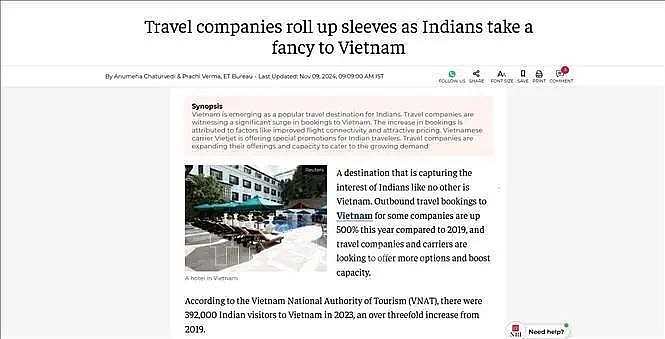 |
| The article on the Economic Times. Screenshot |
Raj Rishi Singh, chief marketing officer and chief business officer for corporate at MakeMyTrip, said over the past year, searches for Vietnam are up 17%.
Vietnam’s affordability, combined with hassle free visa regulations and a growing number of direct flights from India, is fueling this growth among Indian tourists.
SD Nandakumar, president and country head for holidays and corporate tours at SOTC Travel, said Vietnam offers Indian travelers a treasure trove - from culture, history, cuisine, scenic vistas to multiple options for shopping.
The firm intends to showcase the yet under-leveraged locales like the Mekong Delta, Phu Quoc, Hoi An, Sapa, and Con Dao to discerning Indian consumers, he said.
Yinxing weakens into tropical depression, Toraji enters East Sea
At 7 p.m., the tropical depression was located over the western waters of Vietnam’s Hoang Sa (Paracel) Archipelago, packing winds of 50-61 kmh near its center.
By the evening of November 12, the tropical depression is expected to weaken further into a low-pressure area over the mainland of Quang Ngai and Phu Yen provinces.
Due to the impact of the tropical depression, the seas around the Hoang Sa Archipelago will experience strong winds and rough seas, cited VOV.
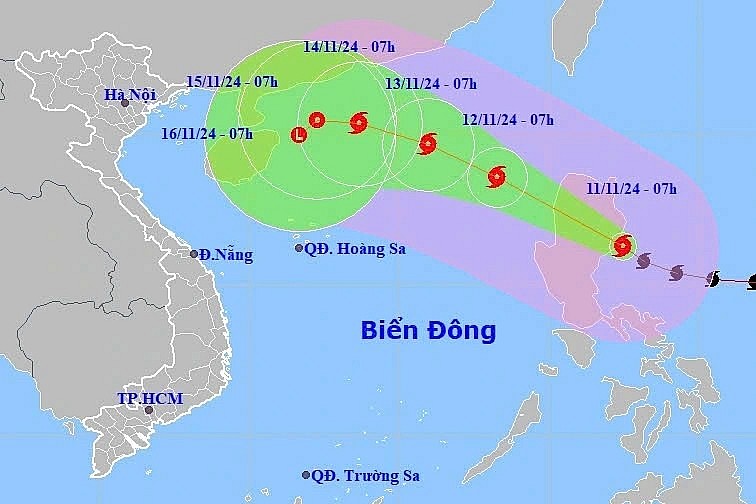 |
| Tracking typhoon Toraji in the East Sea in the coming days. |
Due to the impact of the tropical depression (weakened from Typhoon No. 7), from tonight until the night of November 12, areas
Localities from Thua Thien Hue to Phu Yen will experience moderate to heavy rain and thunderstorms, with rainfall amounts ranging from 70 to 150mm, and some areas exceeding 250mm.
Boats operating in these dangerous areas are likely to encounter thunderstorms, tornadoes, strong winds, and large waves.
Meanwhile, typhoon Toraji crossed the Philippines' Luzon Island and entered the East Sea, becoming the eighth storm of 2024.
At 10 p.m. on November 11, Toraji was located in the eastern part of the East Sea, with maximum wind speeds near the center reaching 103-117 kmh.
In the next 24 hours, Toraji is forecast to move northwest at a speed of about 15-20 kmh, with intensity likely to weaken.
Over the next 48 to 72 hours, the storm will gradually weaken into a tropical depression, and then into a low-pressure area over the eastern waters of China’s Hainan Island.
Vietnam positions itself as a key player in the global semiconductor boom
Vietnam’s semiconductor industry is gaining momentum, drawing interest from global firms looking to diversify their supply chains and access a skilled workforce.
With significant shifts occurring in the global semiconductor industry, Vietnam is striving to elevate its role in the international chip supply chain.
The semiconductor industry profoundly impacts the global economy. Semiconductors are foundational to computing devices and data centers, playing a crucial role in the development of smartphones, IoT devices, and soon the AI era.
Amid these transformations in the global semiconductor sector, Vietnam has emerged as a promising destination with bright growth prospects.
Vietnam is seizing the opportunity to become deeply integrated into the semiconductor industry and has shown a clear ambition to establish itself as a key link in the global semiconductor supply chain.
Commenting on this trend, Dr. Vo Xuan Hoai, Deputy Director of the National Innovation Center (NIC, Ministry of Planning and Investment), noted that many leaders of global semiconductor technology corporations have recently visited Vietnam, along with major testing and packaging firms.
This shows that Vietnam has a strong semiconductor ecosystem, providing an opportunity for global semiconductor firms to explore Vietnam as a potential destination, VNN reported.
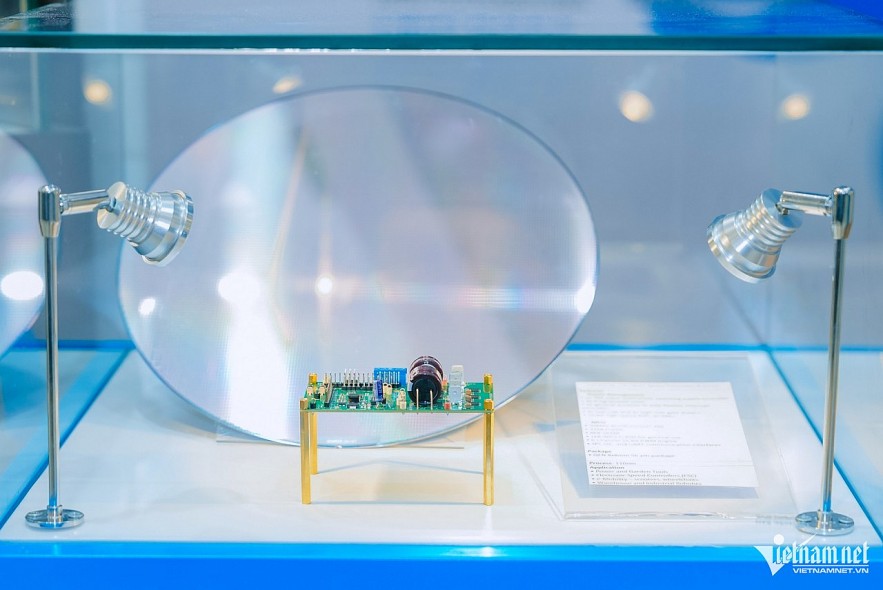 |
| A circuit board with semiconductor components designed and manufactured in Vietnam. Photo: T.D. |
“With the shift of supply chains, particularly from China, Vietnam is one of the nations chosen for deeper integration into the global semiconductor supply chain, thanks to its high-quality and abundant workforce. As a result, Vietnam has become an attractive destination for the semiconductor industry,” Dr. Hoai shared.
According to Dr. Hoai, to boost Vietnam’s position in the global semiconductor supply chain, the country needs to be well-prepared in terms of infrastructure, including power, clean water, and logistics.
Recently, the Vietnamese government and related agencies have made significant efforts to improve infrastructure investments, including power grids, airports, seaports, and highways, to support the growth of this industry.
In addition, the government has focused on creating policies, mechanisms, and incentives to foster the semiconductor industry, with a streamlined “one-stop” system and initial investment support policies.
Vietnam has also launched a national program to develop human resources in the semiconductor sector, aiming to train 50,000 engineers by 2030.
Looking to the future, Nguyen Thi Bich Yen, a senior expert at Soitec, predicted that the semiconductor industry will experience rapid growth from 2025 to 2030.
“The impact of this industry on the economy will be double what it has been over the past 60 years. This is not only an opportunity for Vietnam but for the entire world,” she stated.
According to Yen, the global semiconductor industry, especially with the growth of the AI era, will require over 1 million workers in the coming years. To diversify supply chains, semiconductor companies are turning to Vietnam and Southeast Asia.
Vietnam has a young, eager workforce known for resilience and perseverance, which positions it as a potential provider of skilled semiconductor labor to the world.
From her perspective as an expert, Yen acknowledged that semiconductor manufacturing demands substantial investment. Recently, however, advancements in microchip transistors have slowed, and costs are rising, driving the industry toward advanced packaging technology. This presents an opportunity for Vietnam.
This trend also simplifies chip design, making LED chip design easier than system-on-chip (SoC) design. This could be a niche for Vietnam to explore and get ahead of the curve.
“For long-term development, Vietnam could invest in university laboratories equipped with software to design LED chips. If successful, Vietnam could capture high-level opportunities in the industry,” Yen suggested.
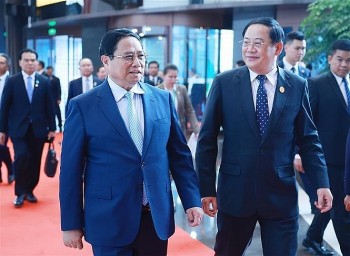 | Vietnam News Today (Nov. 7): Prime Ministers of Vietnam, Laos Meet in Kunming Vietnam News Today (Nov. 7): Prime Ministers of Vietnam, Laos meet in Kunming; State President to attend APEC Economic Leaders’ Week, visit Chile and Peru; ... |
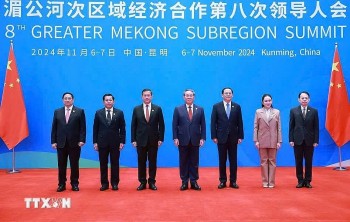 | Vietnam News Today (Nov. 8): PM Pham Minh Chinh Attends 8th Greater Mekong Subregion Summit in China Vietnam News Today (Nov. 8): PM Pham Minh Chinh attends 8th Greater Mekong Subregion Summit in China; Party leader receives outgoing Cuban ambassador; Vietnam proposes ... |
In topics
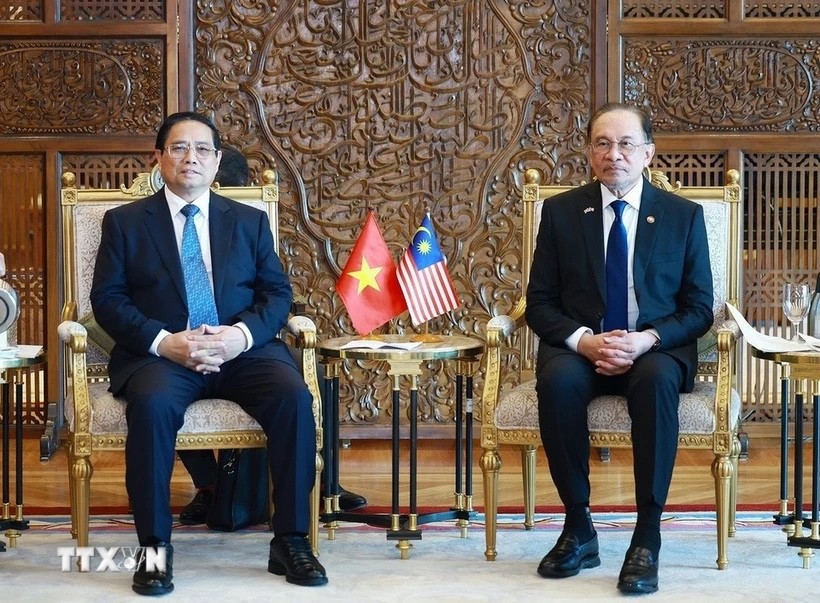 National
National
Vietnam News Today (May 31): Vietnam Strongly Supports Laos’s National Development
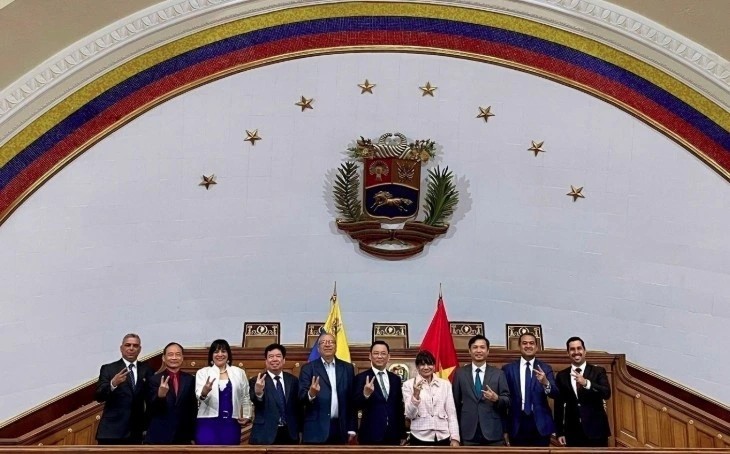 National
National
Vietnam News Today (May 30): Vietnam, Venezuela Reinforce Ties Through People-to-people Diplomacy
Recommended
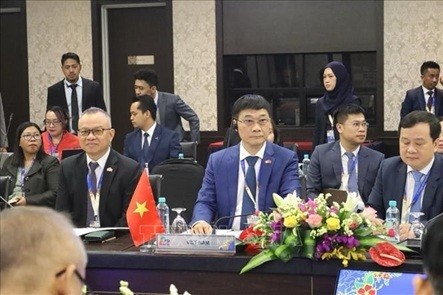 National
National
Vietnam Commits to Building an Inclusive, Sustainable and Cohesive ASEAN
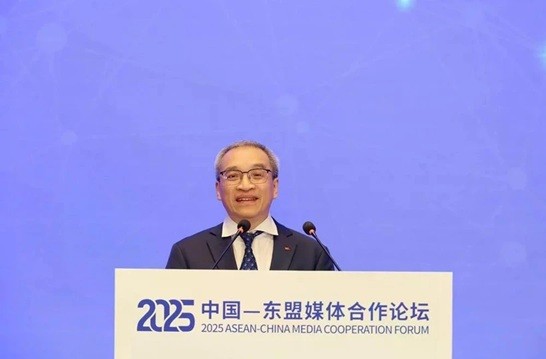 National
National
Vietnam Proposes Vision for Responsible Digital Journalism Cooperation
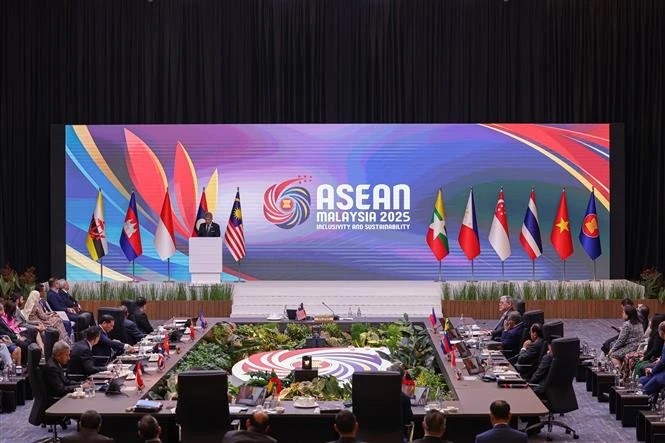 National
National
Vietnam News Today (May 26): Vietnam Attends ASEAN Meetings for Promoting Regional Cooperation
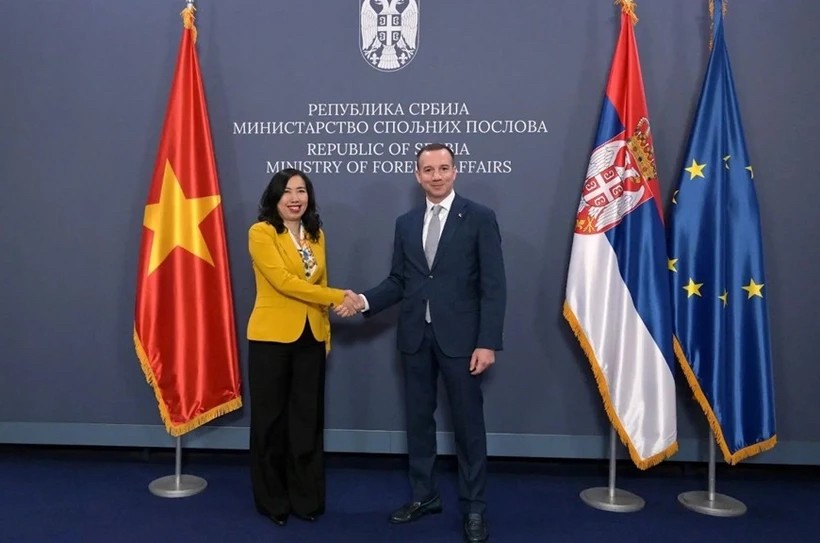 National
National
Vietnam News Today (May 25): Vietnam, Serbia Hold Political Consultation
Popular article
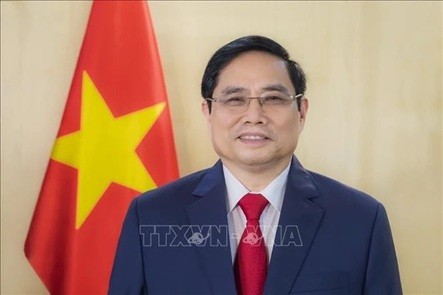 National
National
PM to Depart for Official Visit to Malaysia, Attendance at 46th ASEAN Summit
 National
National
Vietnam News Today (May 23): Vietnam–France Comprehensive Strategic Partnership Opens New Horizons for Cooperation
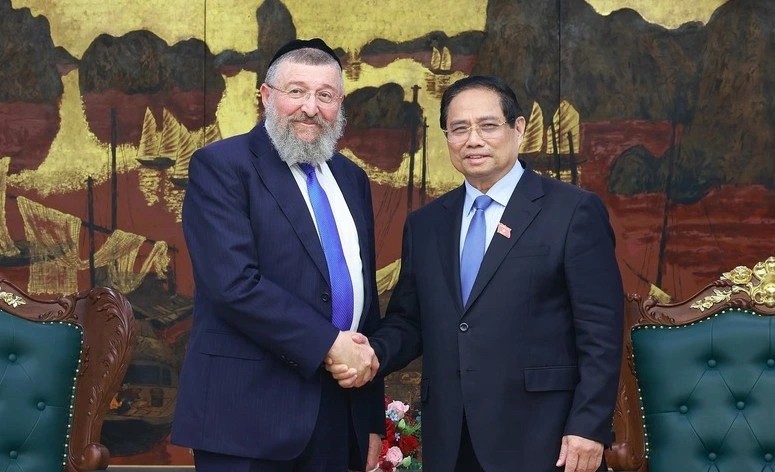 National
National
Vietnam News Today (May 22): Stronger Vietnam-Israel Cooperation Expected in Science, Innovation and Labor
 National
National




